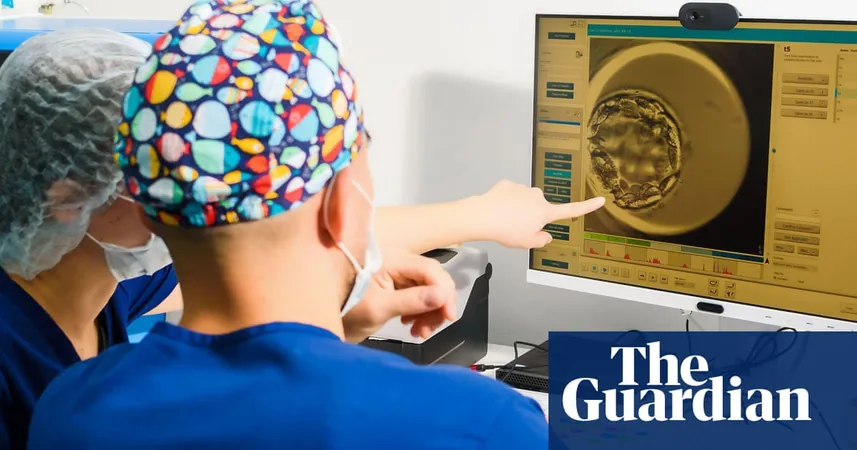
Unlocking Cravings: How Rutgers Uncovered the 'On/Off' Switch for Hunger
2025-06-15
Author: Sarah
Revolutionary Research on Food Cravings
In groundbreaking studies published in *Nature Metabolism* and *Nature Communications*, researchers at Rutgers have unveiled a complex wiring diagram that governs our feelings of hunger and fullness. This revelation could reshape the landscape of weight-loss medications, enhancing their effectiveness while minimizing unpleasant side effects.
Neurons and Cravings: A Fascinating Discovery
Led by Zhiping Pang from the Robert Wood Johnson Medical School, one pivotal study identified a slender bundle of neurons connecting the hypothalamus to the brainstem. These neurons are rich in GLP-1 receptors, the very proteins targeted by popular weight-loss drugs like Ozempic. By using light pulses to activate this pathway, researchers found that well-fed mice immediately ceased feeding. Conversely, silencing this connection or removing its receptors resulted in increased weight gain for the animals.
The Dual Nature of Hunger and Satiety
As fasting altered the neural connections, natural or synthetic GLP-1 could effectively restore them. "Think of this synapse as a volume knob that only gets turned up when energy reserves are low," Pang explained. He cautioned that continuous activation of this signal, as seen with some drugs, could disrupt the brain’s normal functions, leading to nausea, vomiting, and even muscle wasting.
Hunger's 'Accelerator' Circuit Revealed
In another compelling aspect of the research, Mark Rossi, a co-leader at the Center for NeuroMetabolism, mapped a circuit responsible for triggering hunger. This involved examining inhibitory neurons connecting the stria terminalis to the lateral hypothalamus. When stimulated, these circuits prompted mice to race toward sugar water, while blocking them left the animals indifferent, even after prolonged fasting. Hormones like ghrelin and leptin fine-tuned this hunger drive, showcasing a dynamic interplay between energy levels and food-seeking behavior.
Understanding Weight-Loss Drug Dynamics
Remarkably, though the neural circuits operate in distinct brain regions, the studies revealed a shared principle: the state of energy availability can rapidly reconfigure synapses. During fasting, the hunger circuit becomes more sensitive while the satiety circuit loosens its grip, and after eating, this relationship flips.
A New Era for Weight-Loss Medications
This dual mechanism could explain why weight-loss diets and drugs frequently lose effectiveness over time. Current GLP-1 mimics, like Wegovy and Zepbound, generate significant weight loss but often come with drawbacks. Pang's findings suggest a potential treatment focusing on the brainstem's appetite control while minimizing impact on other organs, potentially alleviating the side effects. Meanwhile, Rossi's insights into ghrelin's regulation may aid individuals struggling with plateaus after long periods of dieting.
Looking Ahead: Precision Medicine in Weight Management
Utilizing cutting-edge techniques such as optogenetics and chemogenetics, the researchers could finely tune these pathways, a feat made possible by advances in neural biology. Future studies will delve further into enhancing drug designs. Pang aims to observe real-time GLP-1 release to establish whether brief bursts can effectively regulate appetite, while Rossi seeks to identify the specific molecular features of hunger-triggering cells to develop targeted cravings remedies.
The Future of Eating and Weight Control
As Rossi aptly noted, "You want to maintain the system's flexibility." Striking the right balance between the urge to eat and the decision to stop—without relying on constant suppression through medication—could be a game-changer in future weight-loss strategies.

 Brasil (PT)
Brasil (PT)
 Canada (EN)
Canada (EN)
 Chile (ES)
Chile (ES)
 Česko (CS)
Česko (CS)
 대한민국 (KO)
대한민국 (KO)
 España (ES)
España (ES)
 France (FR)
France (FR)
 Hong Kong (EN)
Hong Kong (EN)
 Italia (IT)
Italia (IT)
 日本 (JA)
日本 (JA)
 Magyarország (HU)
Magyarország (HU)
 Norge (NO)
Norge (NO)
 Polska (PL)
Polska (PL)
 Schweiz (DE)
Schweiz (DE)
 Singapore (EN)
Singapore (EN)
 Sverige (SV)
Sverige (SV)
 Suomi (FI)
Suomi (FI)
 Türkiye (TR)
Türkiye (TR)
 الإمارات العربية المتحدة (AR)
الإمارات العربية المتحدة (AR)